Archive
European Microstates
Today we are going to Europe to review states, known as “microstates”. Indeed, they count only a few kilometers.
Malta
The smallest state within Europe is Malta Island, an archipelago of 320 km2, not far away from Sicilia in Italy. Its capital is Valetta. The republic has inherited the ecclesiastic order of Malta. The region has 400,000 inhabitants, alleged to be Phoenician descendants.
Malta’s economy is based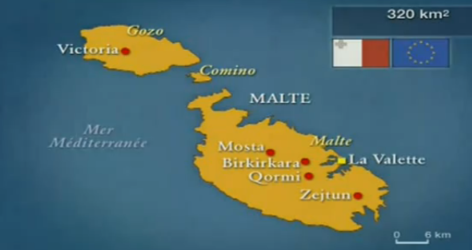 on its attractive tourism, finance, and flag of convenience system (FOC). The latter is being reformed since Malta’s adhesion to Europe in 2004.
on its attractive tourism, finance, and flag of convenience system (FOC). The latter is being reformed since Malta’s adhesion to Europe in 2004.
Malta’s insularity could explain why such a small country has remained independent throughout history. However, it is less evident taking a look at similar state enclosed, locked or even encompassed by superpowers.
San Marino
Let’s first take a look at the state of San Marino, enclosed in Italia. Less than 10kms from the Adriatic Sea, San Marino covers 61 km2 and counts 29,000 inhabitants, one fourth of them are Italians. The capital is San Marino, the national language is Italian, and last but not least it is the oldest republic of Europe. The constitution of 1569 gives authority to a large council constituted by 20 nobles, 20 bourgeois, and 20 farmers. San Marino, establishing a community of Christians to escape from the Roman Empire Diocletian, supposedly created the state in 301.
at the state of San Marino, enclosed in Italia. Less than 10kms from the Adriatic Sea, San Marino covers 61 km2 and counts 29,000 inhabitants, one fourth of them are Italians. The capital is San Marino, the national language is Italian, and last but not least it is the oldest republic of Europe. The constitution of 1569 gives authority to a large council constituted by 20 nobles, 20 bourgeois, and 20 farmers. San Marino, establishing a community of Christians to escape from the Roman Empire Diocletian, supposedly created the state in 301.
How San Marino preserved its independence from the 301 to the XXI? On the one hand, the state’s landscape made it very demanding to invade. On the other hand, in 1740, San Marino benefited from the protection of the Pope, Clement XII, standing against the plans of expansion of Romagna. In 1796, Bonaparte, admiring the republican spirit already existent, spared the microstate. Finally, receiving several Italian revolutionaries such as Garibaldi,San Marino secured its independence in the name of the Italian Unity. The treaty of friendship, signed in 1962, between the two states made official their relationship.
Nowadays, San Marino survives through its tourism and financial system. Furthermore, the state has introduced financial agreements with Italia allowing it the use the euro and even to emit it.
Andorra
Let’s now focus on Andorra.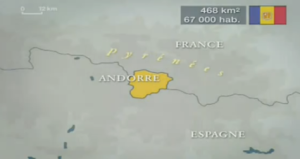 Being enclosed by France and Spain, it is to expect that Andorra benefits from substantial economic interests. The Principality of Andorra is located in the Pyrenean massif. It covers 468 km2 and counts 67,000 inhabitants and last but not least, it is one of the only countries in the world counting more foreigners than nationals. Its capital is Andorra La Vella and the official language is Catalan. Known to be founded in 805 by Charlemagne, Andorra confronts itself to the same problematic: How such a small state preserved its independency?
Being enclosed by France and Spain, it is to expect that Andorra benefits from substantial economic interests. The Principality of Andorra is located in the Pyrenean massif. It covers 468 km2 and counts 67,000 inhabitants and last but not least, it is one of the only countries in the world counting more foreigners than nationals. Its capital is Andorra La Vella and the official language is Catalan. Known to be founded in 805 by Charlemagne, Andorra confronts itself to the same problematic: How such a small state preserved its independency?
Power rivalries between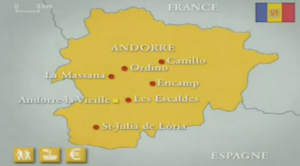 Foix and La Seul d’ Urgell drove the creation of a co-principality in 1278. The bishop of Urgell and the earl of Foix agreed to share their political and juridical authority in Andorra considering themselves as co-princes. From 1278 to the XXI, the rights of the earl of Foix were transmitted to the kings of France and then to the presidency. In 1993, Andorra introduced a new constitution, adopted a parliamentary system, became a sovereign state, adhered to the United Nations, and established agreements with France and Spain, offsetting the microstate lack of army.
Foix and La Seul d’ Urgell drove the creation of a co-principality in 1278. The bishop of Urgell and the earl of Foix agreed to share their political and juridical authority in Andorra considering themselves as co-princes. From 1278 to the XXI, the rights of the earl of Foix were transmitted to the kings of France and then to the presidency. In 1993, Andorra introduced a new constitution, adopted a parliamentary system, became a sovereign state, adhered to the United Nations, and established agreements with France and Spain, offsetting the microstate lack of army.
The country makes a living out its tourism and duty-free sales due to the absence of a tax and a fiscal system. Andorra did not join the European Union in order to save its economic advantages, even if the euro is its national currency.
Liechtenstein
The Principality of Liechtenstein is located in central Europe and bordered by Austria and Switzerland. This territory gathers the seigniories of Schellenberg and Vaduz obtained by Hans Adam, the Prince of Austria in 1719. This Principality is catholic and its official language is German.
is located in central Europe and bordered by Austria and Switzerland. This territory gathers the seigniories of Schellenberg and Vaduz obtained by Hans Adam, the Prince of Austria in 1719. This Principality is catholic and its official language is German.
However in 1818, the political union of German speakers, planned by Austria, is blocked by the Prussian expansion in the region. On its side, Prussia was only aiming at consolidating Germany, forcing Liechtenstein to independency in 1866. The dismantling of the Austrian-Hungarian empire, after the First World War, incited the Principality to enhance its relations with Switzerland. In 1923 the two neighbors decided to implement a monetary and customs union, leading to the use of the Swiss Franc as national currency in Lichtenstein.
only aiming at consolidating Germany, forcing Liechtenstein to independency in 1866. The dismantling of the Austrian-Hungarian empire, after the First World War, incited the Principality to enhance its relations with Switzerland. In 1923 the two neighbors decided to implement a monetary and customs union, leading to the use of the Swiss Franc as national currency in Lichtenstein.
The country covers 160 km2 and counts 35,000 inhabitants, of whom 15% are Swiss and 7% are Austrians. The capital is Vaduz. Thanks to its favorable fiscal system to foundations and firms, the country sees about 35,000 foreign companies growing on its soil. In 2000, the German Secret Service has accused this tax haven to laundry money. Later on the OECD claimed that its cooperation on organized crime was dubious.
Monaco
Our last case study is Monaco.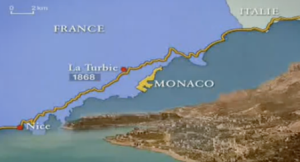 The presence of cliffs, running alongside the southern coast of France, has prevented all forms of circulation for centuries. The road linking France and Italia had gone through La Turbie (in the north) until 1868. That being said, it is to assume that its location (as well as its relation with France) contributed to the continuity of the microstate.
The presence of cliffs, running alongside the southern coast of France, has prevented all forms of circulation for centuries. The road linking France and Italia had gone through La Turbie (in the north) until 1868. That being said, it is to assume that its location (as well as its relation with France) contributed to the continuity of the microstate.
In the XIII, the Grimaldi family is heading the Guelf party favorable to the pope. Being chased away from Genes by the Giblin party in favor or the Holy Roman Empire, the Grimaldi family took refuge in the region of Monaco while asking protection to France. Members of the Grimaldi family became lords owning territories, such as: Roquebrune-Cap-Martin and Menton. As a matter of history, they had been dispossessed of their land during the French Revolution of 1793.
During the re-establishment in 1815, the former lords retrieved some of their lands and contributed to the protection of France in 1861. They undertook the development of casinos attracting clients from all over the world. Creating substantial wealth, the casinos allowed the suppression of tax system in 1869.
Covering only 2 km2,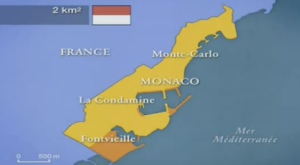 Monaco is the second smallest state in the world after Vatican. Since 2005, the last reigning Grimaldi is the Prince Albert II. Monaco counts 32,000 inhabitants from 120 different countries with 20% of Monegasques, 17% of Italians, and 40% of French. The country is a tax haven with an offshore banking center employing 2,800 persons. Monaco is often suspected of dirty money laundering despite of tougher regulations implemented and disclaimers emitted by the central authority.
Monaco is the second smallest state in the world after Vatican. Since 2005, the last reigning Grimaldi is the Prince Albert II. Monaco counts 32,000 inhabitants from 120 different countries with 20% of Monegasques, 17% of Italians, and 40% of French. The country is a tax haven with an offshore banking center employing 2,800 persons. Monaco is often suspected of dirty money laundering despite of tougher regulations implemented and disclaimers emitted by the central authority.
Its relation with France is central. Monaco has a customs union with France since 1965, leading to the adoption of the euro with the right to emit it agreement with Brussels. French remains the national language. The prince has to choose its prime minister out of list made by the French President. A new agreement since 2002, stipulates that the Principality will remain independent even if the Grimaldi family does not have descendants. Before that, the region had to come back to France in the absence of heirs.
Microstates
The sovereignty of the microstates depends of economic interests. They often are tax havens. However, as we pointed out, we note dating political tradition giving them historical legitimacy. Neither the European Union nor the globalization erodes ties to a location or a history.
depends of economic interests. They often are tax havens. However, as we pointed out, we note dating political tradition giving them historical legitimacy. Neither the European Union nor the globalization erodes ties to a location or a history.
Sources:
Arte, Le Dessous des Cartes – Jean-Christophe Victor: Micro-Etats d’Europe 01/2010